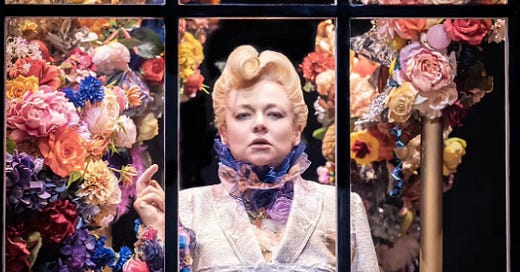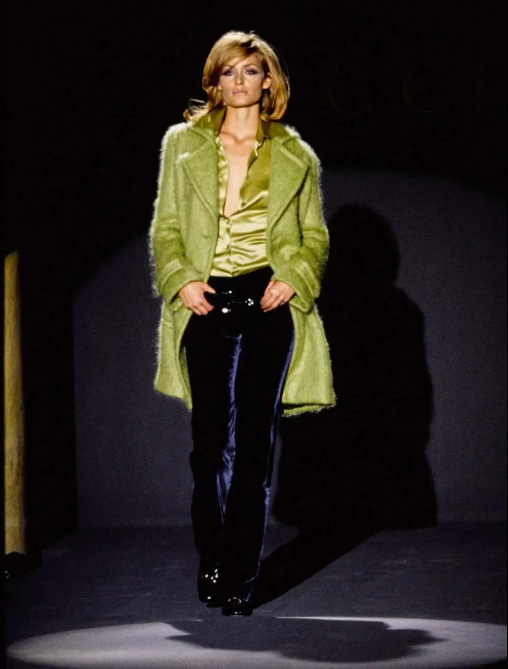Adaptation. Done right, it’s an art form. A delightful act of breathing life into an existing work, either by reinterpreting it in a new medium, bringing it into a different era, or just proving that, hey, the old stuff can still be fun.
Reinventing the classics is quite in at the moment. On Broadway, The Picture of Dorian Gray, Oscar Wilde’s 1891 chronicle of vanity and decadence, has gotten a wildly good and dizzyingly contemporary facelift. In this new imagining, adapted for the stage by Kip Williams, Sarah Snook, she of HBO’s “King Lear but make it 21st-century media dynasty” soap Succession, stars as the titular Dorian, ill-fated painter Basil Hallward, libertine Lord Henry Wotton and dozens of other characters in a one-act, one-woman tour de force.
On stage, Snook is solo, but not alone, her performance aided by a crack team of camera operators, dressers and stagehands, along with several projection screens. The effect for the audience is a highwire act, one that marries a night at the theater with the experience of watching an inventive experimental film being assembled in real time. Along the way, Williams’ script allows for cheeky anachronisms – Donna Summer’s “I Feel Love;” injectable fillers; a fantastic set piece involving an iPhone selfie and some Facetuning – to make their way into Wilde’s late-19th-century London environs. Marg Horwell’s costumes, too, help make for a decidedly of-the-moment affair with looks that feature strong nods to Victoriana while occasionally straddling Bowie-esque glam.
If a multi-media, multi-period, single-performer take on a 135-year-old novel sounds like something designed for only the most pretentious of New Yorker subscribers, fear not. The show is an impressive achievement, yes, but that makes it sound a bit like homework. It’s also really, really fun. Much of that fun stems from Wilde’s prose, with lines like, “To get back one’s youth, one merely has to repeat one’s follies,” still crackling after more than a century. And much stems from Snook’s performance, which shifts from delightfully madcap to emotionally harrowing, with enough grace to make one Google, “Do they make PEDs for actors?” upon exiting the theater. A large portion of the fun, though, springs from the two-hour-long magic trick that the show pulls off – one not limited to its deft integration of technology. Dorian Gray is an incredibly well-known story, so it’s hard to imagine any audience member coming in cold. Somehow, Williams’ adaptation makes it feel both radically new and utterly faithful.
That’s one approach to fresh adaptation: find a once-in-a-lifetime combination of performer and material and combine it with some technological derring-do to render a theatrical experience unlike anything most people have ever seen. Hollywood, specifically Christopher Nolan (no stranger to technological derring-do himself), has another potential means of making a classic feel dynamic: Just add Zendaya. Nolan, who after the wild success of 2023’s Oppenheimer, became the recipient of one of cinema’s biggest blank checks ever, has assembled a massive all-star cast – Matt Damon, Anne Hathaway and Lupita Nyong’o are among the heavy-hitters joining Zendaya – for his next project: a film adaptation of The Odyssey.
Once again,a case of breathing life into an old tale (and it doesn’t get much older than Homer’s epicchronicle of a return trip gone awry). What path Nolan will take with his mega-watt cast is purely conjectural at this point – the movie won’t release until 2026. But he turned a biopic about a physicist into a box-office phenomenon, so odds are that it will be a crowd-pleaser. Homer is, of course, no stranger to adaptation – few authors have been so frequently translated. Most recently, and most buzzily, classicist Emily Wilson has put her plainspoken spin on the blind bard’s great works; she followed up her 2017 The Odyssey with a new edition of The Iliad, released in 2023.
Wilson’s gripping, modern take announces itself in the very first sentence of her Odyssey: “Tell me about a complicated man.” Farewell to A.T. Murray’s “man of many devices,” or George Chapman’s “man…that many a way wound with his wisdom.” Those guys both had good runs (1919 and 1614 respectively), but there’s a new crafty Ithacan in town. Wilson’s work is peppered with other decidedly post-classical verbiage like “canapés” and “tote bag.” She also leans with elan into the bitchy side of Homer’s mythical heroes. After being shot in the foot by Paris, Diomedes directs a few verbal barbs at the pampered Trojan prince. In E.V. Rieu’s 1950 translation, the invective is rendered as “Bowman and braggart, with your pretty lovelocks and your glad eye for the girls.” Wilson goes pithier: “You good-for-nothing archer! Sleazy flirt!/So rude! So cocky in your silly hairstyle!” Meow.
Critical response to Wilson’s work has been overwhelmingly positive. On social media, however, some scolds abound who think she takes too heavy a hand to her lighter approach. Ancient Greek poetry should be a ponderous, dour affair, after all. It should be noted that while Wilson’s translations can be termed breezy, they’re breezy for Homer. Her versions are engrossing, but they’re hardly light reads. Still, it takes a groundbreaking update to fire up internet discourse about a millennia-old poem.
Yes, adaptation is all the rage. There’s nothing like the joy of seeing a classic remixed through a new lens. The Odyssey and The Picture of Dorian Gray have something in common, however, beyond being based on pre-20th-century works. They’re drawing from extremely compelling source material. Dorian Gray features deviancy, moral corruption, witticisms and a scary cursed painting. The Odyssey has murder, mayhem and a sexy witch who turns men into pigs. New spins can amp up the fun factor, but one is already starting from a rich text in the entertainment department. Put differently: To bring something into the here-and-now, it helps to have a substantial there-and-then to build upon.
Which brings us to fashion, a world in which new voices are constantly tasked with putting fresh takes on old labels. Latest batter up: Kering’s star-bright Demna, announced last week as the group’s latest solution to fix Gucci as its incoming creative director. He has a huge challenge ahead.
Demna brilliantly reawakened Balenciaga with his creative audacity, first expressed at Vetements. In the popular imagination, Gucci is about gutsy. Tom Ford made it so with his super-sexy, Seventies-tinged chic that defined not just the “Gucci Girl” but an entire genre of late-20th and early-21st century fashion. After an extended rough patch post-Ford, Alessandro Michele delivered a different kind of intensity in whimsical, quixotic magpie reveries. Given his fearlessness, iconoclasm and the deftly wrought respect he ultimately showed for the house history, on one level, Demna seems a natural for the post. But can he recreate the magic at Gucci?
First there’s the basic matter of mandate: Is it clear? Gucci’s 2022 parting with Michele and signing of Sabato De Sarno announced the corporate intention to pivot the house from hyper fashion to a classics-based position. After three runway seasons, it didn’t work. Now, Demna’s appointment heralds another course reversal, back to a mega-fashion stance. Whether that is a firm commitment or momentary crossing of fingers remains to be seen.
There’s also the question of Demna’s aggressive aesthetic. How does he evolve his daring point of view to return Gucci to the pinnacle of creative and commercial might? After ten years, his creative ethos is well-known. What worked at Balenciaga, a relatively small company, won’t necessarily transfer to the behemoth Gucci. These days in fashion, familiarity, even when beautifully rendered, can fall flat. And that’s without any cultural debacles, although it’s unlikely that Demna will ever again do anything as shocking – and outright confounding – as the 2022 ad campaign that raised accusations of child exploitation.
But successful adaptation requires big swings. Demna didn’t only work fashion’s darker edges to keep Balenciaga at the forefront of fashion “cool” for the better part of a decade. He also made deft use of house codes, particularly in couture, twisting Cristóbal Balenciaga’s often arch concepts into objects of exquisite fascination. In other words, the guy knows how to adapt an archive. While it’s hard to imagine him going heavy into Michele’s strange gentleness, one can envision him unleashing his chutzpah on core elements of the sexed-up Ford era. And, while he’s at it, for added runway impact, why not see if Sarah Snook and her cohort of camera operators are available?









